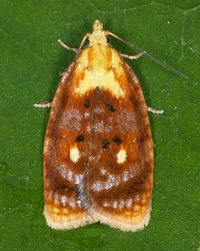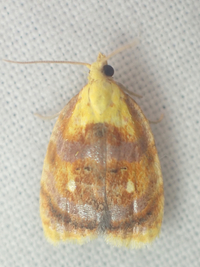Identification
Adult Markings: As with many Acleris species, the adult patterning is variable. In the most common form the palps and head are lemon-yellow, while the thorax is concolorous, but often with variable amounts of brownish-orange scaling. The forewing is predominantly reddish-brown except for a yellowish region on the basal third of the wing that is mostly restricted to the dorsal half, a band of yellowish coloration on the subterminal area that widens towards the apex, and a raised, yellow discal spot near the center of the wing at around two-thirds the wing length. Many specimens also have a narrow line of yellow along most or all of the costa. The subterminal area has a wide, dark reddish-brown band that curves from the anal angle to the outer third of the costa where is joins a similarly colored wide longitudinal band that runs along the costa to the wing base. Collectively, they produce a horse-shoe shaped mark when a resting adult is viewed from above. Blackish, raised scale patches occur on the dorsal half of the wing at around one-third and one-half the wing length, and faint bands of lead-gray scales are sometimes evident on the basal and apical thirds of the wing. The fringe is yellowish and the hindwing is brown. Specimens are occasionally found that deviate substantially from the general description above, including ones with forewings that are nearly uniformly reddish-brown and others that are predominantly yellow, with two curved reddish-brown bands at around one-third the wing length and in the subterminal region.
Adult Structural Features: See genitalia images below.
Adult ID Requirements: Identifiable from good quality photos of unworn specimens.
Immatures and Development: Ponder and Seabrooke (1988) studied this species both in the laboratory and in natural habitats in Newfoundland where blueberries are common. Overwintering occurred in the egg stage and a prolonged freezing treatment was required to trigger the embryos to complete development and hatch. The larvae passed through four instars before pupating, with most instars having a cream-colored body with a dark thoracic shield and black head. The last instar had a yellowish body and a cinnamon-brown head. The thoracic shield was cinnamon-brown medially and shaded to dark-brown laterally. Females in the field laid their eggs singly on dried leaf litter under blueberry plants rather than on live leaves or stems. The embryos completed development in the spring and the hatchlings that emerged burrowed into the closed flower buds of blueberries during the last two weeks of April, leaving a hole with an accumulation of yellow frass. The young larvae subsequently fed on swelling leaf buds. The later instars shifted to feeding on terminal leaf growth that was webbed together and eaten, as well as larger leaves that were folded or webbed together to form shelters. The older larvae appeared to periodically abandon shelters and form new ones based on the increased numbers of abandoned shelters during late-instars. Pupation mostly occurred within the shelters in June, with the males emerging before the females during the first week of July. Females emitted pheromones that mostly attracted males between 2200 and 2400 h.
Larvae ID Requirements: Identifiable from good quality photos, especially where associated with known host plants.

 »
»




 »
»


